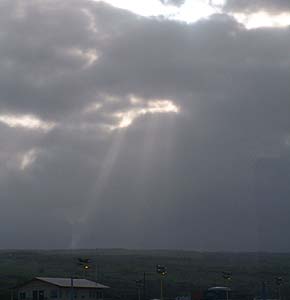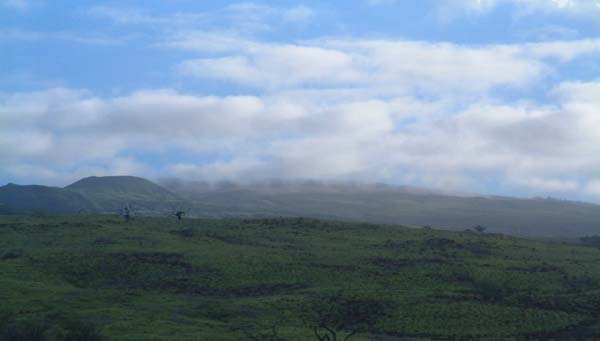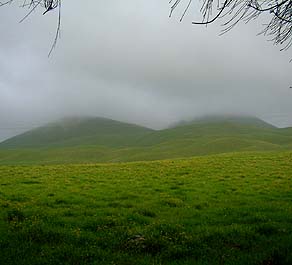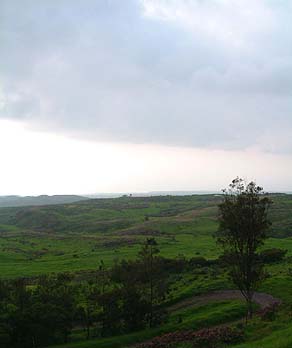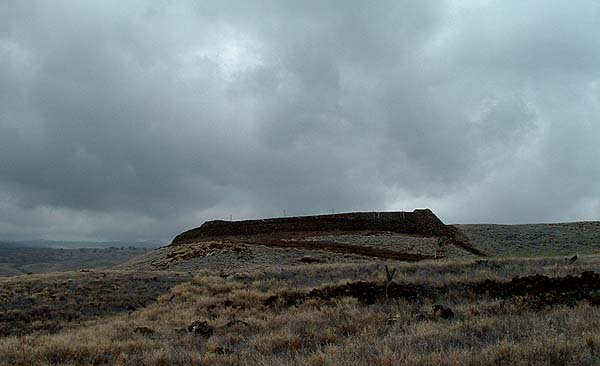 |
 |
 |
|||||
|
|
|||||||
|
|
|||||||
| |
|
|
|
Rain in the uplands of Kawaihae.
|
“The windward side of the Kohola mountains is the north and the northeast side,” Sam says. “And that entire side intercepts the trade winds and gets a lot of moisture. Then, as you move down the leeward side, you lose the clouds and you go into dryer and dryer terrain until you come down to Kawaihae Harbor, which is the driest spot in the whole archipelago. So you go from a very, very wet place down to a very, very dry place, as dry as you can get."
|
||
|
|
||
“I don’t even remember, when I was growing up, having rain,” ‘Ilima says. “I don’t remember. Kawaihae was always dry, always dry. And after we moved here to North Kohala and I was married and I had children, it was raining so much we would take our laundry down to Kawaihae and in half an hour it would be dry. Of course when you dried your laundry down at Kawaihae it would be really stiff because there is no breeze and everything is so hot. "And if we had fish to dry, we would take our fish down there to dry, and what normally takes three days here, in maybe half a day it’s dried. And we made like mango seed. We take it there and one day it would be dry."
|
|
|
“But you know what I realize now, the heat is different from when we were living there. It’s different. For me, Kawaihae, if I’m there too long at the beach, at the parks, the heat gets to be unbearable. And probably because everything now is cement and pavement and it’s different. It’s different, it’s very different. “For several years now, the weather has been so different. It used to be where you can expect rain in a certain month and you would know when you were going to have nice warm weather, but it’s not that way anymore. Now you don’t even know when you’re having rain."
|
|
|
|
|
|
||
|
|
||
"But we had lots of rain up in the mountain," ‘Ilima adds, "and even, it’s unusual to see Mahukona area nice and green. But once it’s starting to, then as soon as the sun comes out, then everything dries up again." "It hardly ever rains in Kawaihae, It hardly ever rains," Lani says, "so when it rains, it means that it’s a storm, then it rains really heavy." "The Naulu wind and rain is is said to come in during the winter storm months, which is when the majority of rain would be falling for Kawaihae," Sam told us on the Winds page. These would be the storms to which Lani refers.
|
|
|
"Down here it rains when it gets Kona weather," stated old-time resident Masaru Doi, in a 1997 interview. "Kona weather" refers to two weather phenomena in the islands. First is the break-down of the trade winds, in which case convection winds like the Naulu become dominant. The other is Kona storms, caused by weather fronts in the winter that bring wind from the South or kona direction. "From what von Holt of Kahua Ranch used to tell us," Doi adds, "when the grass grows in a dry area the cattle get fatter about three times as fast as the wet place. So that's the reason they hang on to the place. During the winter months, they put them in there, when the grass is growing well, they fatten the cattle up" (from Chiogioji & Hammatt 1997: 58).
|
|
|
|
|
The dryness of Kawaihae was noted frequently by early travelers to the area. Archibald Menzies, naturalist who accompanied Vancouver's second visit in 1793, traveled up towards Waimea from Kawaihae. He wrote "I traveled a few miles back...through the most barren, scorching country I have ever walked over....The herbs and grasses which the soil produced in the rainy season were now mostly in a shriveled state, thinly scattered and by no means sufficient to cover the surface from the sun's powerful heat, so that I met with very few plants in flower in this excursion" (Menzies 1920: 55-56, cited in Kelly 1974: 5-6). French explorer de Freycinet wrote that Kawaihae "...is surrounded by even sadder, even drier grounds, if that is possible" than Kealakekua, down in Kona. "Here, in fact, not an atom of greenery appeared before our eyes. One could have said that it had been ravaged by fire" (Freycinet 1978: 41).
|
||
|
|
||
The impact of rainfall on vegetation thus leads to a more detailed discussion of Kawaihae's forest.
|
||
|
|
||
|
|
|
|
|
|

|
| Kawaihae Home | Map Library | Site Map | Hawaiian Islands Home | Pacific Worlds Home |
|
|
|
|
|
|
|||
| Copyright 2006 Pacific Worlds & Associates • Usage Policy • Webmaster |
|||

